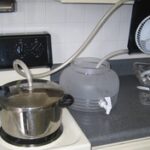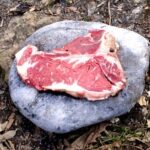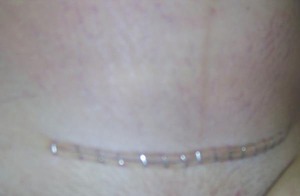To be perfectly honest, there are more ways to cook a steak than there are competent cooks! This is my way, and it works. If you follow these instructions, you will end up with perfect barbecued steaks every single time.
First of all, for steaks, the fire has to be hot and it has to be direct. Don’t mess with low or indirect heat sources – you will end up boiling your steaks in their own juices, and whatever juices are left will all run out the bottom when you turn it over, and your steak will be as dry as an old shoe. And not a moist, tender and delicious shoe either!
There are two essential reasons for the hot fire:
1) Ever since man started using fire, he has liked the flavor of burnt meat; and a well-browned piece of meat is burnt meat, and that gives you flavor. Now don’t burn the hell out of your steak or you will be eating charcoal.
2) What happens when you heat a piece of meat is that the juices want to get away from the heat. So to prevent that, you have to sear the steak on both sides and even around the edges of a thick steak – so that the sear will keep the juices inside. You can’t sear the meat with a cold fire. Just to illustrate this in another way, let me tell you how the Chinese sometimes cook a duck. They clean a duck all out on the inside. Then they tie the neck with a piece of string and fill the cavity with spiced soup and tie up the other end the same way. After that, they cover the outside skin with a soy sauce and honey mixture, and hang the duck in the air to dry. Then they put the thing into a barbecue pit. The process then works almost like a pressure cooker. As the soup heats, it builds up pressure and boils and at the same time cooks the duck meat tender. The soup inside of the duck is like the juices inside a steak; as these liquids heat, they bubble and try to escape. The dry soy-honey glaze on the skin of the duck keeps the soup inside the duck; the brown sear in a steak keeps the juices inside the steak.
I know that the Food Network guys are all about thermometers, but you’re better than that: Learn to cook steak by the touch system. Thermometers poke holes in your steaks for all those delicious juices to run out of! Just use the touch system – you’ll thank me later: Cook it over a hot fire good and brown on one side, then turn it over and start on the other side. Wait a few moments, and poke the steak in the center with your finger. If it’s still very soft, it’s too raw. Leave the steak and, shortly, poke it again. Before long, you will feel it start to stiffen, and that is medium rare. After that, changes happen fast, and, in a matter of moments, the steak goes from medium rare to medium to well done. Now don’t try to poke the steak and judge it the instant that you turn it over. Because right at that point, the heat has driven the juices down in the meat away from the browned side of the meat; they have been trying to get away from that hot-fire side of the steak. The meat will feel hard if you poke it right then, and it won’t be an accurate test. Wait just a half minute, and the juices will have rushed back toward the top of the steak away from the heat. Then you can make an accurate judgment.
Now you are not going to learn this whole technique in this one easy lesson. I didn’t; no one does. Trial and error is the thing, but after awhile, you will be able to cook fifty or a hundred steaks and every damn one of ’em will turn out the way you want them because you will know how they should feel; it’s that simple.
A friend of mine, now long gone, Eddie Farkas of Sacramento, was the damnedest barbecuer. He had a big pair of tongs – maybe fourteen inches and cast iron – which he used for turning the steaks over. Well, Eddie would put the steaks on the grill and brown a side, and then turn them. Then he’d start to bounce the tongs on the steak, he could tell by the way they bounced how done the steaks were. Believe me, he never missed – rare, medium rare, medium. Nobody ever ate a well-done steak at Eddie’s barbecue.
Now for some specifics:
For a fairly thin steak, about three-fourths inch thick: Brown it well over a hot fire on one side. Turn. Within half a minute, put your finger on it to test it, and then leave the steak on the fire until it’s done the way you like it.
If the steak is over one inch thick, you may have to turn it a couple of times.
When steaks are two to three inches thick, start out with five minutes on a side, and you might even sear the edges (not the fat edge, but where the steak was cut). Then feel your steak. If it is too soft in the middle, you may have to turn it over several times. Keep feeling the center!
A final note on doneness: After you’ve turned the steak, little puddles of juice on top mean medium rare to medium, and big puddles of juice mean well done.
Do most of your seasoning at the end – salt tends to leach out the juices, and pepper burns. Season your steaks liberally with salt and fresh ground pepper right before you pull ’em. Just remember, when you are poking your steaks with thermometers, you are making exit holes for all that wonderful juice! By using your fingers and your expertise, you will end up with juicy, flavorful steaks!







